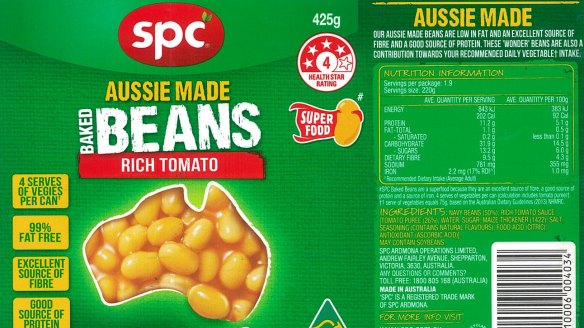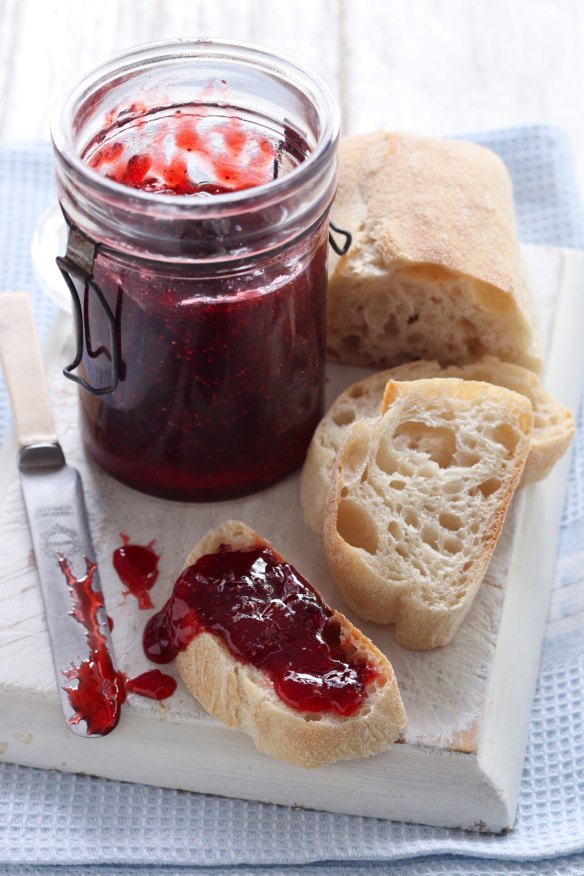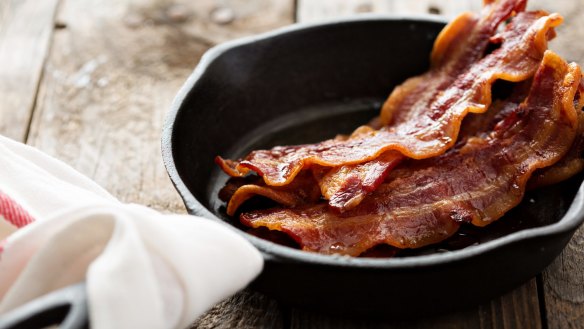The inside story: How to read the label on your food

- You're eating what? Ten of the weirdest additives in food
- Taste metal? You're not nuts, you may have pine mouth
How much salt is low salt? What is E300 and is it bad for you? What is fat free? The nutrition label on a packet of food contains a lot of valuable information on what you are about to consume.
But it can be baffling with dense, fine printed list of ingredients and nutrition on the back while on the front the food manufacturer's marketing department shouts all sorts of claims.

A report by the OECD reveals that 40 per cent of Australians do not have the necessary literacy skills to participate in daily life. This more than likely means many of us struggle to properly understand the labels on our food.
Proof lies in other studies, such as University of Wollongong's study that found some young adults thought that high-energy foods, those higher in kilojoules, would give them more "energy" to get through the day.
Another study by Queensland University of Technology showed that better food literacy led to better nutrition. If you care about your food, you need know how to read a food label. Here's how.
Some compounds will do nothing to one person and cause someone else to break out in a rash.
Use by date vs best before
The Use By date is printed on packs of perishable foods such as milk, meat, fish, salads, deli foods etc. This is probably the most straight-forward part of the food labelling – do not eat food past its Use By date. Best Before dates are stamped on to shelf stable foods such as biscuits, tinned food, frozen and dried foods. The food will be at its best until that date then will slowly deteriorate. It is OK to eat foods after the Best Before date, but common sense would preclude one from eating mouldy or obviously unpalatable or unwholesome food or food from a bulging tin.
Serve size and servings per pack
This is determined by the manufacturer and is useful in estimating how much of a nutrient you are eating. Does the Serve Size reflect real world consumption? For Weet-Bix the serve size is two biscuits. The serving size for Arnott's Barbecue Shapes is 25g or just 10 biscuits. How many people have stopped after 10 Barbecue Shapes? Servings per pack is simply the total weight of the contents divided by serving size.
Nutritional information panel
This is the info box on the back that has three parts. On the left is the column that lists the "component", such as energy, sodium or fat. The first measurement is how much of each component is in a serve. In the right column is how much of the component can be found in 100g of solid or 100ml of liquid. If you consume exactly the serving size as outlined in the middle column then you will know how much salt, fat and protein etc you're consuming. By reading the far right column you can work out the percentage of fat or sugar in the food. In the right-hand column of a Nutri-Grain cereal panel it reads Sugars 26.7g, which means Iron Man food is made up of over a quarter sugar – 26.7 per cent to be exact.
Energy
Energy describes how much fat and carbohydrate is in the food and is measured in kilojoules or kJ. The higher this figure is per serve, the higher the number of kilojoules. The recommended daily intake for the average adult is 8700 kJ. This figure can vary massively. A high-performance athlete or farm worker may need double this while a small elderly person may require only 6000kJ. (You can work your recommended energy intake based on your age, height and weight at nrv.gov.au/dietary-energy.) Foods packed with fat and sugar will have a higher energy figure regardless of their weight. For example, a meat lover's pizza might be 1200kj for a 100g serve while a simple margherita could be about 800kj for the same weight. (See fat and carbohydrates below also.)
Protein
Essential for muscle and tissue growth for healthy people, but for the 1 in 10 Australians with kidney disease a low protein diet takes the strain off ailing kidneys. A food high in protein would have 12g of protein per 100g.
Fat
There are usually two lines on this. The top figure shows the total amount of fat and the next line shows saturated fat. Eating a lot of saturated fat can increase your blood cholesterol, in particular the bad (LDL) cholesterol. Animal fats are high in saturated fat, but so is coconut oil and palm oil. Saturated fat is found in animal fat but also in oils used in baking. A choc chip cookie could have 21g/100g of fat, 17g of which is saturated fat. Any food with under 3g fat per 100g is classed as low in fat.
Carbohydrate
This includes the total mass of all the starches from flour, corn, potatoes, rye plus the sugars derived from cane sugar as well as fruit, honey and milk. The second line breaks out the sugars from this total. In other words, not just added sugar, but all the sugars, including fruit sugar, lactose in milk, glucose in honey. For example, a supermarket Christmas fruit cake made with 20 per cent dried fruit could contain 51g of carbohydrate, of which 32g are sugars. But not cane sugar – almost all of that 32g comes from the dried fruit. A pavlova shell, however, might have 90g of carbohydrates and 90g of sugars meaning all the carbs are sugars.
Sodium
Sodium does not mean salt. Salt is NaCl or sodium chloride. In a 5g teaspoon of salt there are roughly 2g of sodium and 3g of chloride. (To get a rough idea of how much salt is in your food read the number of milligrams of sodium per serve. Multiply by 2.5 then divide by 1000.) The World Health Organisation recommends that we eat no more than a teaspoon or 5g of salt a day. This includes salt in bread, cheese, butter, biscuits plus all the naturally occurring salt in meat and vegetables. Bread, for example, is around 400mg of sodium per 100g. Two slices of a popular old-fashioned style loaf of bread deliver 456mg of sodium or over a fifth of the WHO safe salt limit. Add salty cheese and Vegemite and there's your teaspoon of salt in just one sandwich. Any food with 600mg/100g is considered high in salt and food lower than 120mg/100g is considered "low in salt".
Ingredients
The ingredients are listed by weight, from the ingredient in the "largest quantity and end with the ingredient in the smallest quantity", according to Food Safety Australia New Zealand (FSANZ), the body that oversees food labelling. Here is the ingredients list for a popular brand of strawberry jam. Strawberries (50%), White Sugar, Brown Sugar, Lemon Juice, Fruit Pectin. You can see that the greatest ingredient by weight is fruit. A cheaper house brand's ingredients read: Glucose-Fructose Syrup (from Wheat), Strawberries (40%), Sugar, Pectin, Citric Acid. The latter is made with a chemically created syrup as its greatest ingredient and costs about a third the price of the former.

FOOD ADDITIVES
Humans have been preserving food for millennia, adding salt to olives, and saltpetre (potassium nitrate) to salami. Both are naturally occurring but in large amounts are harmful. Salt causes heart disease and saltpetre has been linked with bowel cancer. Yet we eat them almost every day. Most food additives are used to add shelf life to industrial foods – to hold colour, texture, flavour and to stop food going off. Some additives we are familiar with such as additive 300. It is a bread dough enhancer that speeds up baking. It is also a powerful antioxidant. It is also known as Vitamin C. Then there are additives derived from petro chemicals such as imitation vanilla flavouring, as opposed to natural vanilla. Additives are described by their function then a number in brackets, for example Preservative (224). You will need to go to the web and look up 224 to work out that is a commonly used chemical called sodium metabisulphate. All food additives have been deemed safe by FSANZ.
Colours
The naturally occurring colours in fruit, veg and other food deteriorates and changes with heat, light and time. Food manufacturers rebalance this by adding colour. These are identified by their E numbers 100-181. A colour may range from E120, made from crushed up cochineal beetles, to the factory made artificial colouring Erythrosine cherry red or E127 which has been linked with cancer in rats. Reacting to consumer concerns about additives the food industry is moving towards the "clean label", in which artificial additives, particularly colours, are replaced by plant derived dyes. But all humans are not the same and some compounds will do nothing to one person and cause someone else to break out in a rash. Take the colouring annatto or 160b. You'll find this rubbed on cheese to make it orange or in sauces to make Mexican food red. It comes from the seeds of the achiote tree. and a very small number of people who eat react with symptoms from rashes to anaphylaxis. Natural food colours are becoming the norm derived from plants such as turmeric-coloured E100 that has virtually replaced E102 tartrazine yellow – associated with hyperactive behaviour in children.
Flavour enhancers
Because packaged food is made mostly with commodity ingredients that are then heavily processed, artificial flavour is added back to make it flavoursome. A popular brand of chicken nuggets has Natural Flavour as one of its ingredients. This is hydrolysed vegetable protein known as HVP. It is a process where a vegetable protein, such as soy, is treated with a hydrochloric acid to create a product that is mostly amino acids that tastes delicious. It's a chemist's version of soy sauce. Flavour enhancers are E number 600-699. Additive 621, a.k.a. MSG is the most famous and controversial synthetic flavour enhancer. The CSIRO just published a communique that there are no studies that link MSG with adverse health affects. That said there is empirical evidence that a small number of people have adverse reactions to MSG. There are more powerful flavour enhancers such as Potassium guanylate 628 Sodium inosinate 631. Asthmatics should avoid both.
Preservatives
Preservatives stop bacteria that could kill us or make us sick. Mostly they make packaged food last longer. They cover the E200-299 range. It's the sulphur-based additives that draw the most attention, namely 220 to 228. Found in wine and dried fruit they have been associated with breathing difficulties and asthma. Vitamin C or additive 300 is often added to soft drinks as an antioxidant. Sodium benzoate E211, a preservative, is also added to soft drink. But when added together they can form benzene, a carcinogen. Other compounds that people are concerned about are sodium nitrite E250 and sodium nitrate E251 typically used in the production of bacon and salami and because they can be converted into nitrosamines in the stomach. The WHO have linked nitrosamines with an increased risk of cancer so the Cancer Council suggest reducing your intake of processed meat along with red meat.
Emulsifiers
These are compounds that help fat and water stay in an emulsion, the way egg makes water-based vinegar and fatty olive oil make a beautiful mayonnaise. They cover the numbers 400-499 which includes thickeners and stabilisers. Ice cream makers can use seaweed-derived carrageenan (407) or chemical-derived emulsifiers such as carboxymethylcellulose (466) and polysorbate-80 (433). The latter have been associated with disruptions to gut bacteria and metabolic conditions in test rodents.
Health claims
Claims on the front of a pack such as "low salt" are really useful for people trying to avoid salt. By regulation, for manufacturers to claim a food is "low salt" it must contain 120mg or under of salt per 100g. A "salt-reduced" food must contain at least 25 per cent less salt than the original product. However if a food was very salty to begin with and was reformulated to have 25 per cent less salt, it could still be high in salt. A reduced fat product must have at least 25 per cent reduction of fat on the original. A food that claims that it is light or lite means nothing unless it backed by one of the previous claims. Light olive oil, for example, does not mean that it is low in fat but that it is low in flavour and, most likely, comes from inferior refined olive oil. The words "Gluten Free" are often stamped on products that would never normally contain gluten, such as orange juice. However once the gluten free claim is made there can not be any detectable gluten. A food that claims to be high in fibre must contain at least 4g of fibre per serve. The claim "baked not fried" insinuates low fat but the Arnott's new reformulated "oven-baked" Shapes are still 22.4 per cent fat. Full cream milk, by comparison, is just 3.8 per cent fat.
Invisible ingredients
Due to food labelling laws there are some things you will never know about your food. With genetically modified organisms (GMOs) there is no way to tell If the oil used in your biscuits was derived from GMO canola or if the meat in your pie came from a cow fed on GMO feed. There are things called processing aids that are not required to be mentioned on the label. There is clay used to make wine clear and enzymes used to make meat more delicious. There are plans to spray viruses on chicken to get rid of harmful bacteria – they are called bacteriophages and you will never know they were used.
To learn more
If you want to learn more about food additives or even how to break the code of the back label of nutrition and ingredients then nutritionist Catherine Saxelby has developed exceptionally easy but quite in depth courses and ebooks on her website foodwatch.com.au.
The best recipes from Australia's leading chefs straight to your inbox.
Sign up- More:
- Health and nutrition
